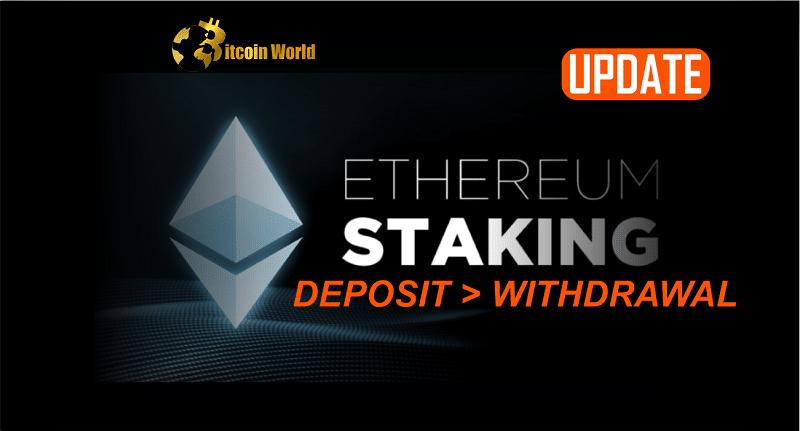The Ethereum staking landscape is shifting! Just days after the highly anticipated Shapella upgrade unlocked the ability to withdraw staked ETH, a fascinating trend has emerged: deposits are now outpacing withdrawals. Let’s dive into what this means for the future of Ethereum and the broader crypto market.
The Tide Turns: Deposits Outstrip Withdrawals
For the past day or so, the narrative around Ethereum staking has taken an interesting turn. After the initial rush to withdraw staked ETH following the Shapella upgrade, we’re now seeing a surge in new deposits. According to data from Nansen’s Shapella dashboard, this shift occurred late on April 17th, with deposits consistently exceeding withdrawals since then. In just the last hour recorded by Nansen, there were a notable 7,020 deposits compared to a mere 154 withdrawals. This marks a significant change in sentiment and activity within the Ethereum staking ecosystem.
Decoding the Data: What Do the Numbers Tell Us?
While the general trend is clear, it’s worth noting that different analytics platforms provide slightly varying figures. Here’s a breakdown of what key platforms are reporting:
- Nansen: Shows a clear dominance of deposits over withdrawals in recent hours.
- Token Unlocks: Reports a total of 1.08 million ETH withdrawn since the Shapella upgrade. However, they also highlight that a substantial 575,000 ETH has been newly staked within the first week post-upgrade.
This data suggests that the net decrease in the overall staking balance is much smaller than the total withdrawals might initially imply – approximately 500,000 ETH. Looking ahead, if the current trend of more deposits than withdrawals continues, both Nansen and Ultrasound predict that the total amount of Ethereum staked will actually increase. Current estimates place the total staked ETH between 18.4 and 18.7 million, depending on the data source.
Token Unlocks further indicates a growth of 26,680 ETH in the staking balance within the last 24 hours alone. However, it’s important to remember that a significant withdrawal queue still exists. Nansen estimates that 5.2%, or 979 million ETH, is currently pending removal, a large portion of which is attributed to the shutdown of Kraken’s staking services in the US earlier this year.
Why the Shift? Understanding the Deposit Dynamics
So, what’s driving this renewed interest in depositing ETH for staking? Several factors could be at play:
- Confidence in the Upgrade: The successful execution of the Shapella upgrade likely instilled confidence in potential stakers, demonstrating the network’s ability to handle complex transitions smoothly.
- Attractive Yields: Even with the ability to withdraw, staking rewards remain an attractive incentive for long-term ETH holders.
- Reduced Liquidity Concerns: The Shapella upgrade addressed the previous concern of locked-up capital, making staking a more appealing option.
- New Entrants: The upgrade may have attracted new participants who were previously hesitant to stake due to the inability to withdraw.
Is More Staking Always Better? A Word of Caution
Interestingly, some industry experts suggest that extremely high levels of ETH staking might not necessarily be a universally positive development. As BeInCrypto pointed out earlier this week, lower staking levels could potentially be bullish for the price of ETH due to reduced selling pressure. The reasoning is that less staked ETH could mean more ETH is available on exchanges, potentially increasing demand and price. It’s a nuanced perspective that highlights the complex interplay of factors influencing cryptocurrency markets.
ETH Staking vs. Other Layer-1s: A Different Landscape
Despite the current surge, it’s projected that ETH staking might not reach the exceptionally high levels seen on some other layer-1 blockchains. This is largely attributed to Ethereum’s diverse range of applications beyond just staking. The utility of ETH in DeFi, NFTs, and other areas means that not all ETH holders will prioritize staking as their primary use case.
Price Performance: Riding the Post-Shapella Wave
The price of ETH has shown resilience in the aftermath of the Shapella upgrade. For the past six days, it has consistently remained above the $2,000 mark. After a slight dip, the asset has recovered and is currently trading around $2,095 (at the time of writing). Notably, Ethereum has gained almost 11% in the week following the upgrade, indicating positive market sentiment. However, at these current levels, ETH is facing some resistance. A significant move will be needed to break through this barrier, while a downward swing could see support tested again near the $1,900 level.
Key Takeaways: What Does This Mean for You?
- Staking Dynamics are Evolving: The post-Shapella era is witnessing a dynamic shift in staking behavior, with deposits currently outweighing withdrawals.
- Confidence is Growing: The successful upgrade appears to have boosted confidence in Ethereum staking.
- Monitor the Metrics: Keep an eye on data from platforms like Nansen and Token Unlocks to track the ongoing trends in deposits and withdrawals.
- Consider the Implications: Understand the potential impact of staking levels on ETH price and network security.
- Do Your Research: Before making any decisions about staking, carefully consider your risk tolerance and investment goals.
Looking Ahead: The Future of Ethereum Staking
The recent surge in Ethereum staking deposits signals a renewed interest and confidence in the network’s long-term prospects. While the initial focus was on withdrawals, the market is demonstrating a strong appetite for staking. The interplay between deposits, withdrawals, and ETH’s price will be fascinating to observe in the coming weeks and months. The Shapella upgrade has undoubtedly ushered in a new chapter for Ethereum staking, and the data suggests a positive trajectory for the continued growth and adoption of this crucial aspect of the network.
Disclaimer: The information provided is not trading advice, Bitcoinworld.co.in holds no liability for any investments made based on the information provided on this page. We strongly recommend independent research and/or consultation with a qualified professional before making any investment decisions.


